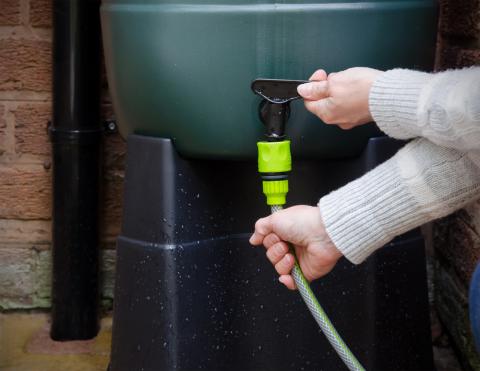We all know that clean, fresh drinking water is in limited supply, but we typically use high quality mains water to flush our toilets and water our gardens – tasks that don’t necessarily need potable water.
So, wouldn’t it make more sense for us to save the limited drinking water we have, and find an alternative for these tasks? Thanks to rainwater harvesting, we can do just that.
What is rainwater harvesting?
Put simply, rainwater harvesting is the process of collecting, storing and re-using the rainwater that falls on your site.
Rainwater harvesting systems come in various shapes and sizes, from a simple water butt – a large plastic container that collects water from a drain pipe – to a pump feed system, which involves a large water tank with a pump that can distribute water around your site.
How can businesses use rainwater?
Traditionally, the water collected by rainwater harvesting systems was largely used for watering gardens. Rainwater can be particularly useful for this purpose during very dry summers, like the one we’ve just seen, as rainwater systems are exempt from hosepipe bans.
In recent years, we’ve found new (non-potable) uses for rainwater, from flushing toilets to cleaning equipment. Bear in mind that the quality of the water you need will depend on its intended usage – if you’re using rainwater to flush toilets, or in cooling systems (like your boiler), for example, low quality water will probably be fine. However, if you’re planning to use it for cleaning equipment or process cleaning, then you will need to treat the rainwater further before it is put to use.
How can my business benefit from rainwater harvesting?
By re-using rainwater in place of mains water, wherever possible, you should be able to reduce your overall water consumption. According to the Rainwater Harvesting Association, you could reduce your water consumption by as much as 40%! If you’re on a meter, this should bring your water bills down – boosting your bottom line.
Becoming more water efficient by investing in a rainwater harvesting system is also a great way to show your customers that your business is concerned about the environment and working to mitigate the environmental impacts of your business activities.
If your building is required to comply with the Building Research Establishment Environmental Assessment Method (BREEAM), you may be able to earn credits through rainwater harvesting. Credits are awarded based on the percentage of the total hard surface on your site, like your roof and your car park, that’s designed to enable rainwater harvesting. You can earn up to three credits, which requires you to have over 50% of your hard surfaces designed for rainwater harvesting. To see the full criteria, click here.
Saving water in your business
Rainwater harvesting is just one of many ways that you can reduce your business’s water consumption, and potentially lower your water costs as a result. To explore new ways for your business to become more water efficient, visit the Water Efficiency section of our Insight hub.

